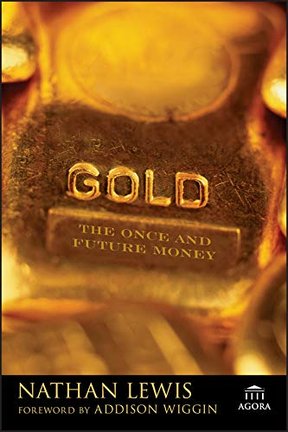Nathan Lewis talks about his books, GOLD and financial apocalypse
- дата: 3 августа 2021 (источник от 1 августа 2021)
Hi, everyone, this is Dmitriy Balkovskiy and let me introduce my recent interview with one of the world’s leading experts on gold investment and gold as money – Nathan Lewis. Over the years Nathan has published several formative texts on gold standard, its history and economic underpinnings. Among them: Gold – the Once and Future Money published in 2007 by Wiley which I translated into Russian and published here in Russia in 2011.
https://goldenfront.ru/articles/view/futuregold/
Since then he published several more books on the same topic:
Gold: The Monetary Polaris and Gold: the Final Standard.
Nathan continues with regular comments on matters financial and economic and you can read it on his website New World Economics, - https://newworldeconomics.com/.
And he also publishes an investment newsletter titled Polaris Letter https://polarisletter.substack.com/
I linked both of these services in the description below.
This interview is roughly divided into three parts, Nathan first talks about his books and the experience in the gold investment community over the past 20 years, gold price forecasts for the next 5 years and possible scenarios for great financial changes in the near future.
So without further ado – Nathan Lewis!
Dmitriy Balkovskiy: Good day, ladies and gentlemen and this is Dmitry Balkovskiу talking to Нейтан Льюис one of the top five experts on gold and gold standard issues in the world and we've spoken a lot quite a few years ago and now we're doing a reunion. Gold and silver issues are back on the agenda, they have been for the past probably two years so we want to touch base and see what changed over this period of time over the past 10 12 15 years and discuss where it might go in the near future in the next 12-24 months.
Nathan Lewis: Great to be here yes good to see youthe last time we spoke was probably 2015or something, maybe um even earlier 2011 or 12 orsomething like that. So now i have four books out mostly about economics not investing directly. This is what I call the gold trilogy, three books about the gold standard. The first was “Gold the once and future money” and that came out in English in 2007 and actually had a Russian edition in 2011 i believe.
Yes and it was also published in Korean, Chinese and German so although that came out in 2007 I actually wrote most of the book in 2000 so it was really inspired by the crises of the late 1990s now it's all ancient history but it was supposed to be a timeless book and I think it has stood the test of time. And then I followed up with two other books “Gold the monetary Polaris” in 2013 and “Gold the final standard” in 2017 and then I wrote another book “The magic formula” in 2019 which has the monetary elements to it.
I'm actually working on a fifth book now, it’s actually about inflation co-authoring it with Steve Forbes, and Elizabeth Ames. It should be out next year.
Particularly since 2019 or so inflation has been a hot topic and covered all the responses of central banks and all this crazy stuff now we have cryptocurrencies and so forth to talk about, so it's been an exciting time and all these topics are becoming more relevant.
I think over time there's growing sophistication in people's thinking that may eventually lead people back toward the idea of a gold standard system.
Dmitriy Balkovskiy: What changed first of all do you still believe in the possibility of a gold standard in some shape or form? The cryptocurrencies didn't really move, I've seen you have this beautiful piece on the can of artists shit. I just thought it was very nice so it doesn't seem that you were swayed by any of this newfangled stuff so what's your view?
Nathan Lewis: Things have come a long way actually there have always been gold standard fans, but when i first kind of got involved publicly at the beginning of the 2000s they embraced the idea of a gold standard system but there was very little sort of theoretical backing to it. It was like just this hodgepodge of silly nonsense. you know like Murray Rothbard, fractional reserve banking you know devalue the dollar so it matches the amount of gold you have in the vault, the era of this silly garbage. People at the time mocked gold standard fans even though Allen Greenspan was kind of keeping the dollar linked to gold at that time.
They mocked gold standard fans and for the most part the gold standard people deserved to be mocked because it was just so horrible in those days. So you know my first book was aimed at amending a lot of those problems, because I hung around in the 1990s and the early 2000s with the intellectual elite of these topics and learn from them more or less directly from direct personal contact. And what i learned from that is there were people who understood these topics pretty well, it was a really small number like less than 10. And none of them ever wrote anything down so the number never grew above 10 right and they're all getting old so I undertook a 20-year project to write these things down and expand them and not just record what was known, but i think our understanding has expanded quite a lot since then.
And that has to a certain degree spread out and people have read the books and gotten a lot more sophisticated about these things. Another thing that happened before the 2008 crisis people really had no idea what central banks did, and it was just a mystery box. And that's true I remember people just had no idea, central banks had some kind of interest rate policy and not just the general public but even wall street professionals and so forth.
They paid a lot of close attention but it was just all about interest rates, they didn't really know what was going on inside the box and 2008 crisis because central bank started doing all this weird stuff. It's not about interest rates anymore they're doing discount lending. So they had to figure it out so the kind of general understanding of what central banks do or can do.
And their range of actions became a lot more sophisticated in that time and that's still ongoing it's becoming a lot more sophisticated now i think so that's been good. And the other thing is right around 2009 bitcoin began and bitcoin itself i think is mostly just a speculative football.
But there are thousands of cryptocurrencies and also what came out was a whole genre of stable coins like tether linked to something and there's now probably a dozen gold length stable coins which are actually pretty good. About five years ago I went to a conference on or talked to a purveyor actually of a gold link stable coin, he had a list of all the gold link stable coins in the world, and you know out of like 60 names about five actually had a coin the rest were just ideas.
Dmitriy Balkovskiy: I think you published it I remember.
Nathan Lewis: Yes it's interesting I just got a rundown of the gold stable coin world that was even just 2018 or so and it was very nascent but now it's starting to become a lot more viable. And also the big dollar stable coin is the most obvious thing have a stable coin link to a dollar have stable coin linked to the euro even in 2019 tether had an outstanding market cap, an outstanding balance of like 2 billion which seemed like an incredible number. Now they're up to 60 or so that expanded 30 times in the last two years.
And along the way I was actually involved a little bit in a stable coin project in 2019 and got an idea of what was going on so what happened was there were all these very smart guys, computer science guys and these tech people were starting to get interested in a dollar stable coin or whatever.
Their bright idea was a commodity basket like stable coin. There was every kind of variation, these smart technically-minded people were learning it from scratch as opposed to economists. The training of an economist is they read something in the book, they're told to regurgitate it and most of them never move beyond that.
And other thing of course is that they actually made the things so they actually did work right, they were tested in a sense and if they didn't do things properly things blew up in their face. So there's been this dramatic expansion of knowledge among stable coin people. So those involved in the crypto space evolved into the stable coin space, learnt how to do these things and what you can and can't get away with.
There all these very strange variations like algorithmic stable coins and so forth, they tried them and some of them worked while others weren't so hot. I think that has been a big change and the last thing to point out for a long time i've kind of expected a world turning historical event. You know the hypothesis that many people are familiar with now you could see the elements of crisis coming together.
You're not American so you might not know this but in the United States in 1855 everyone was talking about the growing problem of slavery and how it had to be resolved somehow but there was nobody who knew that the Civil war was going to start in 1860 or 1861. So they could see things lining up but they couldn't say what was going to happen and in a similar sort of way a lot of things that were illustrated in the book titled “Fourth turning” from the 90s are obviously coming together very much as described.
And I think Covid launched this new period of chaos and disorder. Everyone has this feeling that we're not going back to the way things were and something's going to happen so it's a very interesting time. I think now is the time when central banks might make a big mess of things and also when new ideas can actually be implemented.
Dmitriy Balkovskiy: This is what I was actually really wanted to hear from you. You being probably not a proper gold bug, but a proponent of gold standard but without craziness and apocalyptic leanings. You know who Doug Casey is, right? There is this Doug Casey syndrome, you know, predicting the apocalypse in the next 12 months and it never happens, even though he was right on many occasions but you know the event, which so many people have been expecting, hasn't happened yet it doesn't mean that it will never happen…
You know what i'm driving it what's your view of all this?


Комментарии 0
Добавить комментарийПожалуйста, войдите или зарегистрируйтесь, чтобы оставить комментарий.